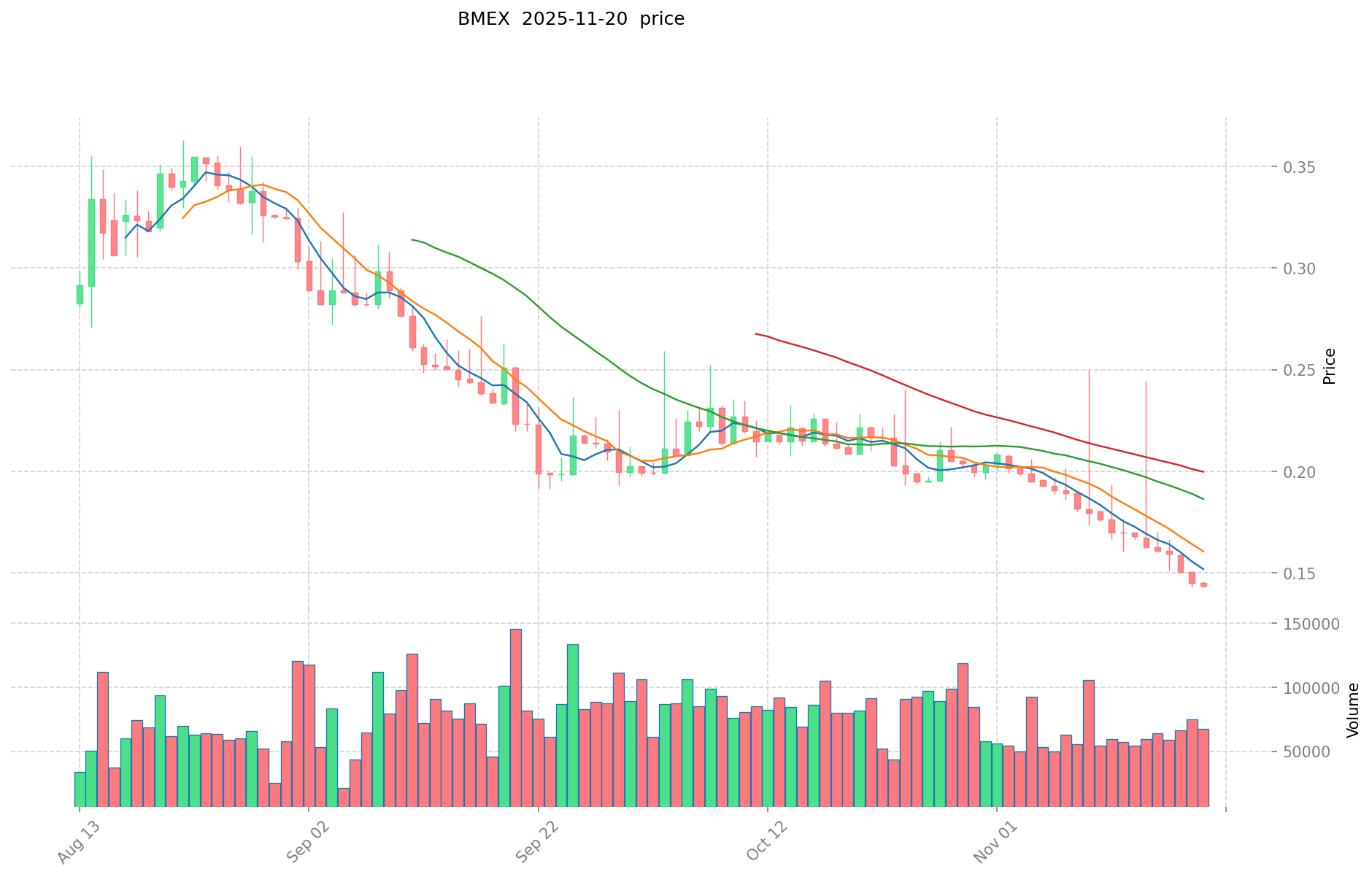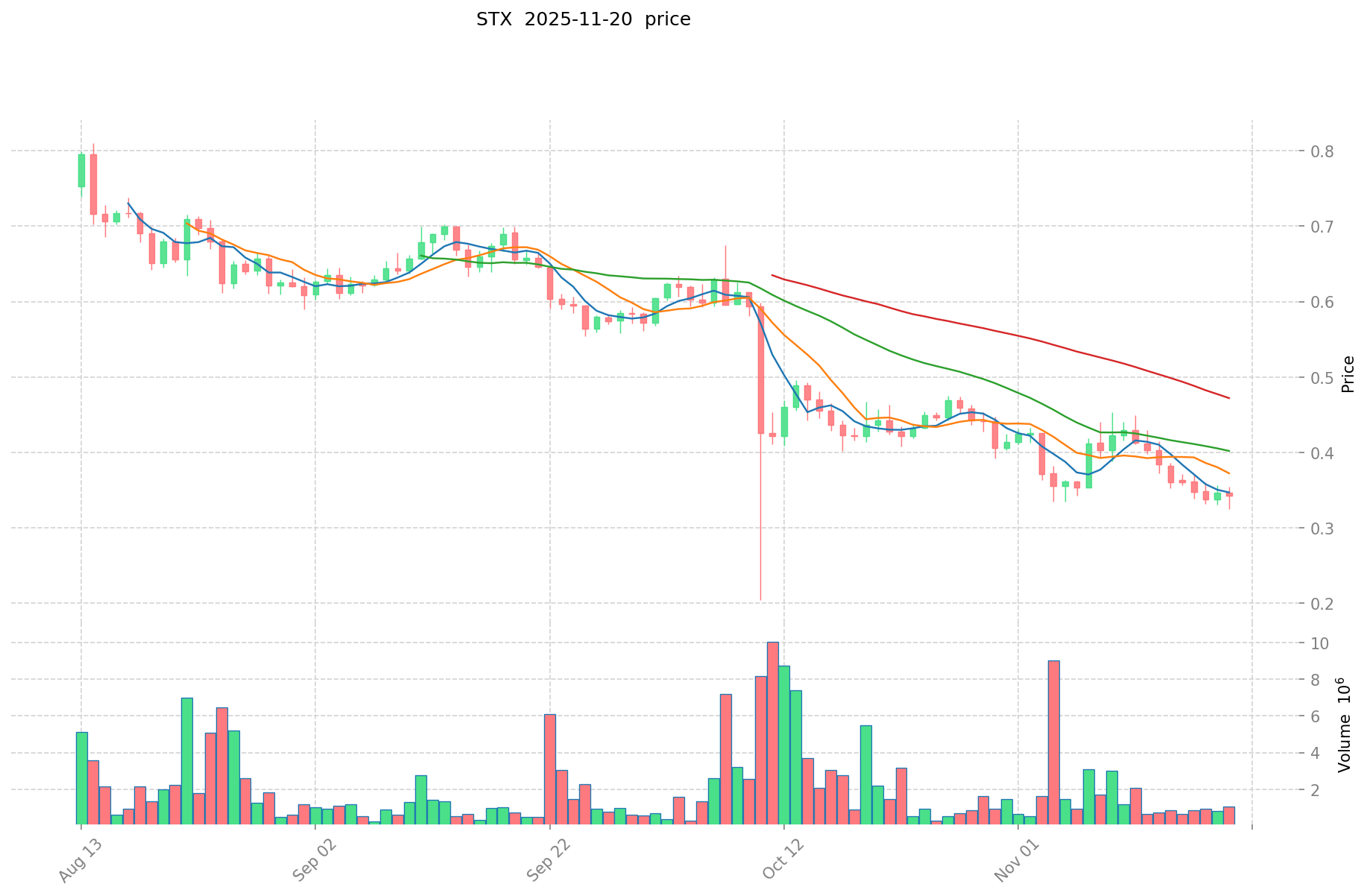BMEX vs STX: Comparing Two Leading Cryptocurrency Derivatives Exchanges
Introduction: BMEX vs STX Investment Comparison
In the cryptocurrency market, the comparison between BMEX vs STX has always been a topic that investors can't avoid. The two not only have significant differences in market cap ranking, application scenarios, and price performance, but also represent different positioning in crypto assets.
BMEX (BMEX): Since its launch in 2022, it has gained market recognition for its role as a utility token in the BitMEX ecosystem.
STX (STX): Introduced in 2019, it has been hailed as the "Google of blockchain," aiming to create a new decentralized internet.
This article will provide a comprehensive analysis of the investment value comparison between BMEX vs STX, focusing on historical price trends, supply mechanisms, institutional adoption, technological ecosystems, and future predictions, attempting to answer the question investors care about most:
"Which is the better buy right now?"
I. Price History Comparison and Current Market Status
BMEX and STX Historical Price Trends
- 2023: BMEX reached its all-time high of $0.6 on April 14, 2023.
- 2024: STX hit its all-time high of $3.86 on April 1, 2024.
- Comparative analysis: BMEX has fallen from its peak of $0.6 to a current price of $0.1431, while STX has dropped from $3.86 to $0.3493.
Current Market Situation (2025-11-20)
- BMEX current price: $0.1431
- STX current price: $0.3493
- 24-hour trading volume: BMEX $10,471.41 vs STX $338,551.52
- Market Sentiment Index (Fear & Greed Index): 11 (Extreme Fear)
Click to view real-time prices:
- Check BMEX current price Market Price
- Check STX current price Market Price


II. Core Factors Affecting BMEX vs STX Investment Value
Supply Mechanisms Comparison (Tokenomics)
-
BMEX: Fixed maximum supply of 100 million tokens with 70 million in circulation
-
STX: Total supply of 1.818 billion with a decreasing issuance rate and mining-based distribution
-
📌 Historical pattern: Limited supply assets like BMEX tend to create price pressure during increased demand periods, while STX's mining-based model creates more predictable issuance.
Institutional Adoption and Market Applications
- Institutional holdings: STX appears to have more institutional interest with backing from major VCs and institutional investors
- Enterprise adoption: STX has broader enterprise applications through its Bitcoin L2 solution and smart contract capabilities for businesses
- National policies: Both operate in a developing regulatory landscape, with STX potentially having more regulatory clarity due to its longer market presence
Technical Development and Ecosystem Building
- BMEX technical development: Being developed as part of the BitMEX ecosystem with focus on trading utility and ecosystem rewards
- STX technical development: Established Layer 2 solution for Bitcoin with smart contract capabilities, Stacks 2.0 blockchain, and upcoming Nakamoto release
- Ecosystem comparison: STX has a more developed ecosystem with DeFi applications, NFT platforms, and Bitcoin-backed smart contract functionality; BMEX primarily serves as a utility token within the BitMEX exchange ecosystem
Macroeconomic Factors and Market Cycles
- Performance in inflationary environments: STX potentially offers better inflation protection through its Bitcoin connection and broader use cases
- Macroeconomic monetary policies: Both tokens are influenced by broader crypto market conditions and monetary policies
- Geopolitical factors: STX's Bitcoin-anchored technology may provide more resilience during geopolitical uncertainty due to its connection to Bitcoin's established security model
III. 2025-2030 Price Prediction: BMEX vs STX
Short-term Prediction (2025)
- BMEX: Conservative $0.097716 - $0.1437 | Optimistic $0.1437 - $0.18681
- STX: Conservative $0.31365 - $0.3485 | Optimistic $0.3485 - $0.428655
Mid-term Prediction (2027)
- BMEX may enter a growth phase, with estimated prices ranging from $0.1607765895 to $0.2155090455
- STX may enter a strong growth phase, with estimated prices ranging from $0.424035196875 to $0.63823854375
- Key drivers: Institutional capital inflow, ETF, ecosystem development
Long-term Prediction (2030)
- BMEX: Base scenario $0.268631512098975 - $0.343848335486688 | Optimistic scenario $0.343848335486688+
- STX: Base scenario $0.751454411291718 - $0.841628940646725 | Optimistic scenario $0.841628940646725+
Disclaimer: The above predictions are based on historical data and market analysis. Cryptocurrency markets are highly volatile and subject to rapid changes. These projections should not be considered as financial advice. Always conduct your own research before making investment decisions.
BMEX:
| 年份 | 预测最高价 | 预测平均价格 | 预测最低价 | 涨跌幅 |
|---|---|---|---|---|
| 2025 | 0.18681 | 0.1437 | 0.097716 | 0 |
| 2026 | 0.17682285 | 0.165255 | 0.11733105 | 15 |
| 2027 | 0.2155090455 | 0.171038925 | 0.1607765895 | 19 |
| 2028 | 0.282180018465 | 0.19327398525 | 0.112098911445 | 35 |
| 2029 | 0.29953602234045 | 0.2377270018575 | 0.130749851021625 | 66 |
| 2030 | 0.343848335486688 | 0.268631512098975 | 0.174610482864333 | 87 |
STX:
| 年份 | 预测最高价 | 预测平均价格 | 预测最低价 | 涨跌幅 |
|---|---|---|---|---|
| 2025 | 0.428655 | 0.3485 | 0.31365 | 0 |
| 2026 | 0.485721875 | 0.3885775 | 0.3419482 | 10 |
| 2027 | 0.63823854375 | 0.4371496875 | 0.424035196875 | 24 |
| 2028 | 0.7635256441875 | 0.537694115625 | 0.408647527875 | 53 |
| 2029 | 0.852298942677187 | 0.65060987990625 | 0.520487903925 | 85 |
| 2030 | 0.841628940646725 | 0.751454411291718 | 0.698852602501298 | 114 |
IV. Investment Strategy Comparison: BMEX vs STX
Long-term vs Short-term Investment Strategies
- BMEX: Suitable for investors focused on exchange utility tokens and ecosystem rewards
- STX: Suitable for investors interested in Bitcoin layer 2 solutions and decentralized internet potential
Risk Management and Asset Allocation
- Conservative investors: BMEX: 30% vs STX: 70%
- Aggressive investors: BMEX: 50% vs STX: 50%
- Hedging tools: Stablecoin allocation, options, cross-currency portfolios
V. Potential Risk Comparison
Market Risks
- BMEX: Highly dependent on BitMEX exchange performance and user adoption
- STX: Susceptible to Bitcoin market fluctuations and overall crypto market sentiment
Technical Risks
- BMEX: Limited ecosystem beyond exchange utility, potential for reduced relevance
- STX: Scalability challenges, network stability during high-load periods
Regulatory Risks
- Global regulatory policies may have different impacts on both tokens, with STX potentially facing more scrutiny due to its broader applications and smart contract functionality
VI. Conclusion: Which Is the Better Buy?
📌 Investment Value Summary:
- BMEX advantages: Limited supply, exchange utility token, potential for growth within BitMEX ecosystem
- STX advantages: Bitcoin layer 2 solution, smart contract capabilities, broader ecosystem and institutional adoption
✅ Investment Advice:
- New investors: Consider a higher allocation to STX due to its broader use cases and potential for long-term growth
- Experienced investors: Balanced approach with both tokens, leveraging BMEX for exchange-specific benefits and STX for wider crypto ecosystem exposure
- Institutional investors: Focus on STX for its institutional backing and potential for enterprise applications
⚠️ Risk Warning: The cryptocurrency market is highly volatile, and this article does not constitute investment advice. None
VII. FAQ
Q1: What are the main differences between BMEX and STX? A: BMEX is a utility token for the BitMEX ecosystem, while STX is a Layer 2 solution for Bitcoin with smart contract capabilities. BMEX has a fixed supply of 100 million tokens, whereas STX has a total supply of 1.818 billion with a mining-based distribution model.
Q2: Which token has shown better price performance historically? A: STX has shown better historical price performance, reaching an all-time high of $3.86 in April 2024, compared to BMEX's all-time high of $0.6 in April 2023.
Q3: How do the ecosystems of BMEX and STX compare? A: STX has a more developed ecosystem with DeFi applications, NFT platforms, and Bitcoin-backed smart contract functionality. BMEX primarily serves as a utility token within the BitMEX exchange ecosystem.
Q4: What are the long-term price predictions for BMEX and STX by 2030? A: By 2030, BMEX is predicted to reach $0.268631512098975 - $0.343848335486688 in the base scenario, while STX is predicted to reach $0.751454411291718 - $0.841628940646725 in the base scenario.
Q5: Which token might be more suitable for institutional investors? A: STX appears to be more suitable for institutional investors due to its broader enterprise applications, institutional backing from major VCs, and potential for long-term growth in the decentralized internet space.
Q6: What are the main risks associated with investing in BMEX and STX? A: For BMEX, the main risks include dependence on BitMEX exchange performance and limited ecosystem beyond exchange utility. For STX, risks include susceptibility to Bitcoin market fluctuations, scalability challenges, and potential regulatory scrutiny due to its broader applications.
Q7: How should new investors approach allocating between BMEX and STX? A: New investors might consider a higher allocation to STX due to its broader use cases and potential for long-term growth in the decentralized internet space. However, it's important to conduct thorough research and consider individual risk tolerance before making any investment decisions.
Share
Content